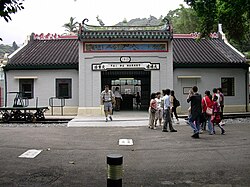文字就係
符號嘅一種,用嚟表示
概念、記綠
口語、
事、
物,用作人同人溝通嘅一種媒介。
歷史 最古老嘅文字主要都係基於
象形符號同埋
表意符號呢啲元素嘅自然
語標。大部分書寫系統都可以廣泛噉歸為三個類別:
語標、
音節 同埋
字母 (亦或係
segmental);之但係,各種變化性好大嘅書寫系統入便是但揀出嘅任何一種,呢三種類別通通都可以喺其中搵倒。噉樣就通常就好難單一分類某一種書寫系統。嗰啲
語標、
音節同埋
字母三者相混,好難分類嘅系統就經常用
複雜系統嚟描述。
書寫系統嘅種類 主文: 意音文字 A
logogram is a single written character which represents a complete grammatical word. Most
Chinese characters are classified as logograms.
每個符號代表一個字,準確啲係代表一個
語素, many logograms are required to write all the words of language. The vast array of logograms and the memorization of what they mean are the major disadvantage of the logographic systems over alphabetic systems. However, since the meaning is inherent to the symbol, the same logographic system can theoretically be used to represent different languages. In practice, this is only true for closely related languages, like the
Chinese languages, as syntactical constraints reduce the portability of a given logographic system.
Japanese use Chinese logograms extensively in its writing systems, with most of the symbols carrying the same or similar meanings. However, the semantics, and especially the grammar, are different enough that a long Chinese text is not readily understandable to a Japanese reader without any know
ledge of basic Chinese grammar, though short and concise phrases such as those on signs and newspaper headlines are much easier to comprehend.
While most languages do not use wholly logographic writing systems many languages use some logograms. A good example of modern western logograms are the
Hindu-Arabic numerals — everyone who uses those symbols understands what
1 means whether he or she calls it
one,
eins,
uno,
yi,
ichi or
ehad. Other western logograms include the
ampersand &, used for
and, the
at sign @, used in many contexts for
at, the
percent sign % and the many signs representing units of currency (
$,
¢,
€,
£,
¥ and so on.)
Logograms are sometimes cal
led ideograms, a word that refers to symbols which graphically represent abstract ideas, but linguists avoid this use, as Chinese characters are often
semantic–
phonetic compounds, symbols which include an element that represents the meaning and element that represents the pronunciation. Some nonlinguists distinguish between
lexigraphy and
ideography, where symbols in lexigraphies represent words, and symbols in ideographies represent words or morphemes.
The most important (and, to a degree, the only surviving) modern logographic writing system is the Chinese one, whose characters are used, with varying degrees of modification, in Chinese, Japanese, Korean, Vietnamese, and other east Asian languages. Ancient Egyptian hieroglyphics and the Mayan writing system are also systems with certain logographic features, although they have marked
phonetic features as well, and are no longer in current use.
See List of writing systems for a list of predominantly-logographic writing systems. 意音文字 主文: 音節文字 As logographic writing systems use a single symbol for an entire word, a
syllabary is a set of written symbols that represent (or approximate)
syllables, which make up
words. A symbol in a syllabary typically represents a
consonant sound followed by a
vowel sound, or just a vowel alone. In a true syllabary there is no systematic graphic similarity between
phonetically related characters (though some do have graphic similarity for the vowels). That is, the characters for "ke", "ka", and "ko" have no similarity to indicate their common "k"-ness. Compare
abugida, where each
grapheme typically represents a syllable but where characters representing related sounds are similar graphically (typically, a common consonantal base is annotated in a more or less consistent manner to represent the vowel in the syllable).
Other languages that use syllabic writing include
Mycenaean Greek (
Linear B) and
Native American languages such as
Cherokee. Several languages of the
Ancient Near East used forms of
cuneiform, which is a syllabary with some non-syllabic elements.
See List of writing systems for a list of syllabaries. 字母 主文: Abugida An
abugida is an alphabetic writing system whose basic signs denote consonants with an inherent vowel and where consistent modifications of the basic sign indicate other following vowels than the inherent one.
Thus, in an abugida there is no sign for "k", but instead one for "ka" (if "a" is the inherent vowel), and "ke" is written by modifying the "ka" sign in a way that is consistent with how one would modify "la" to get "le". In many abugidas the modification is the addition of a vowel sign, but other
possibilities are imaginable (and used), such as rotation of the basic sign, addition of diacritical marks, and so on.
The obvious contrast is with
syllabaries, which have one distinct symbol per
possible syllable, and the signs for each syllable have no systematic graphic similarity. The graphic similarity comes from the fact that most abugidas are derived from abjads, and the consonants make up the symbols with the inherent vowel, and the new vowel symbols are markings added on to the base symbol.
The
Ethiopic script is an abugida, although the vowel modifications in Ethiopic are not entirely systematic.
Canadian Aboriginal Syllabics can be considered abugidas, although they are rarely thought of in those terms. The largest single group of abugidas is the
Brahmic family of scripts, however, which includes nearly all the scripts used in
India and
Southeast Asia.
The name
abugida is derived from the first four characters of an order of the Ge'ez script used in some religious contexts. The term was coined by
Peter T. Daniels.
See List of writing systems for a list of abugida-based writing systems.  Abugida 主文: 輔音字母
Abugida 主文: 輔音字母 The first type of alphabet that was developed was the
abjad. An abjad is an alphabetic writing system where there is one symbol per consonant. Abjads differ from regular alphabets in that they only have characters for
consonantal sounds. Vowels are not usually marked in abjad.
All known abjads (except maybe
Tifinagh) belong to the Semitic family of scripts, and derive from the original Northern Linear Abjad. The reason for this is that
Semitic languages and the related
Berber languages have a
morphemic structure which makes the denotation of
vowels redundant in most cases.
Some abjads (like Arabic and Hebrew) have markings for vowels as well, but only use them in special contexts, such as for teaching. Many scripts derived from abjads have been extended with vowel symbols to become full alphabets, the most famous case being the derivation of the
Greek alphabet from the Phoenician abjad. This has mostly happened when the script was adapted to a non-Semitic language.
The term
abjad takes its name from the old order of the
Arabic alphabet's
consonants Alif, Bá, Jim, Dál, though the word may have earlier roots in
Phoenician or
Ugaritic.
Abjad is still the word for alphabet in
Arabic, Malay, and
Indonesian.
See List of writing systems for a list of abjad-based writing systems. 輔音字母 A
featural script represents finer detail than an alphabet. Here symbols do not represent whole
phonemes, but rather the elements (features) that make up the
phonemes, such as
voicing or its
place of articulation. Theoretically, each feature could be written with a separate letter; and abjads or abugidas, or indeed syllabaries, could be featural, but the only prominent system of this sort is
Korean Hangul. In Hangul, the featural symbols are combined into alphabetic letters, and these letters are in turn joined into syllabic blocks, so that the system combines three levels of phonological representation.
寫字方向 decodeunicode 50,000 glyphs, Unicode Wiki
About African writing systems by the
John Henrik Clarke Africana Library at
Cornell University:
- http://www.library.cornell.edu/africana/Writing_Systems/Welcome.html
General about writing systems
- Omniglot
Alphabetic Writing Systems
Michael Everson's Alphabets of Europe
The Unicode Consortium
 伺服器" align="left" style="padding:10px" />
伺服器" align="left" style="padding:10px" /> 






 大件事
大件事 Abugida
Abugida 歷史
歷史 響呢日死嘅人
響呢日死嘅人 參選名單(1987至2007年)
參選名單(1987至2007年)
 電影資料
電影資料



 大件事
大件事

 住宅區
住宅區
 童年
童年


 響呢日出世嘅人
響呢日出世嘅人 course/inter03.jpg" alt="香港鳥類" align="center" style="padding:10px" />
course/inter03.jpg" alt="香港鳥類" align="center" style="padding:10px" /> 
